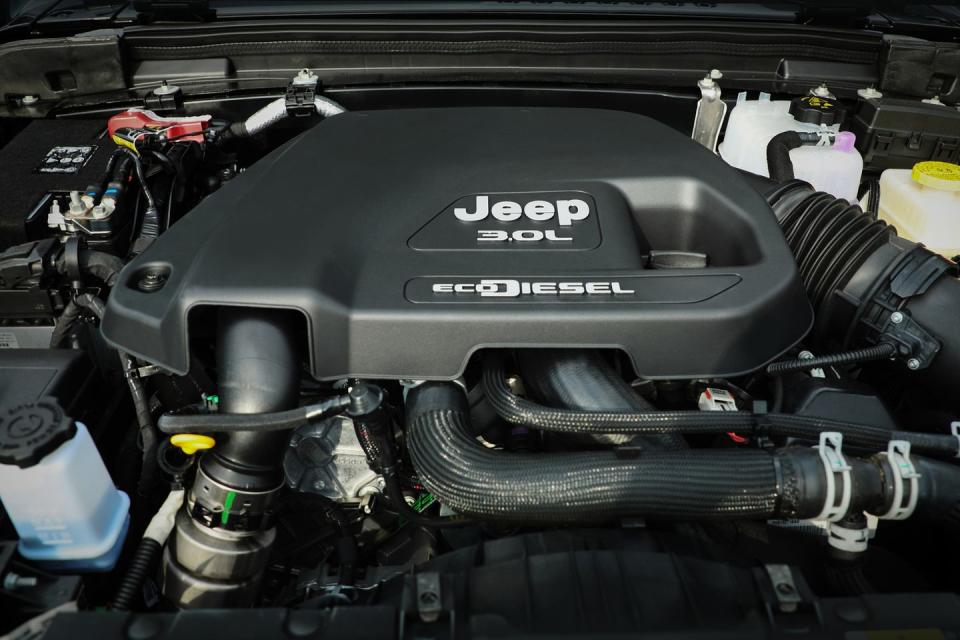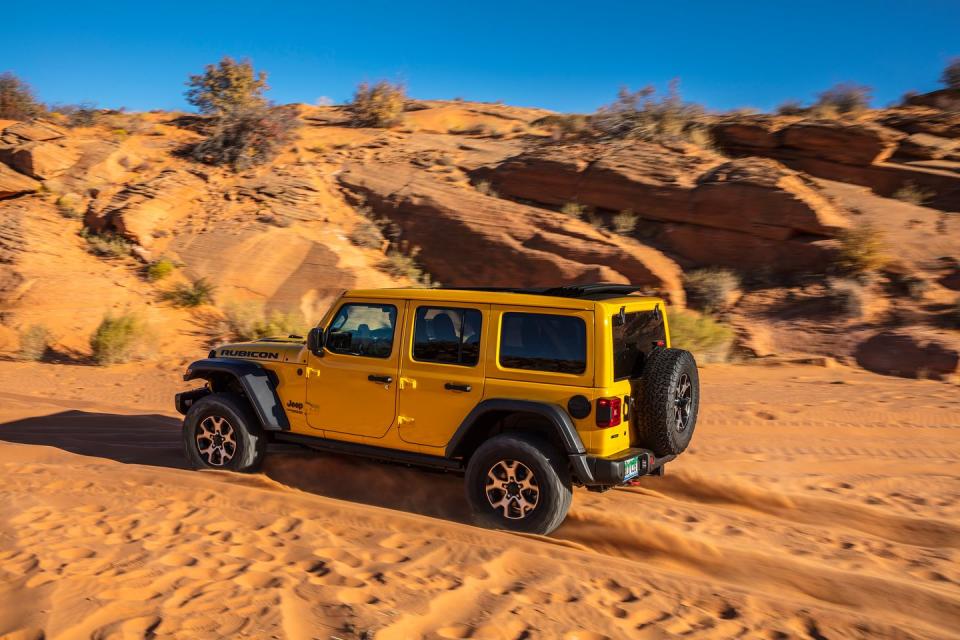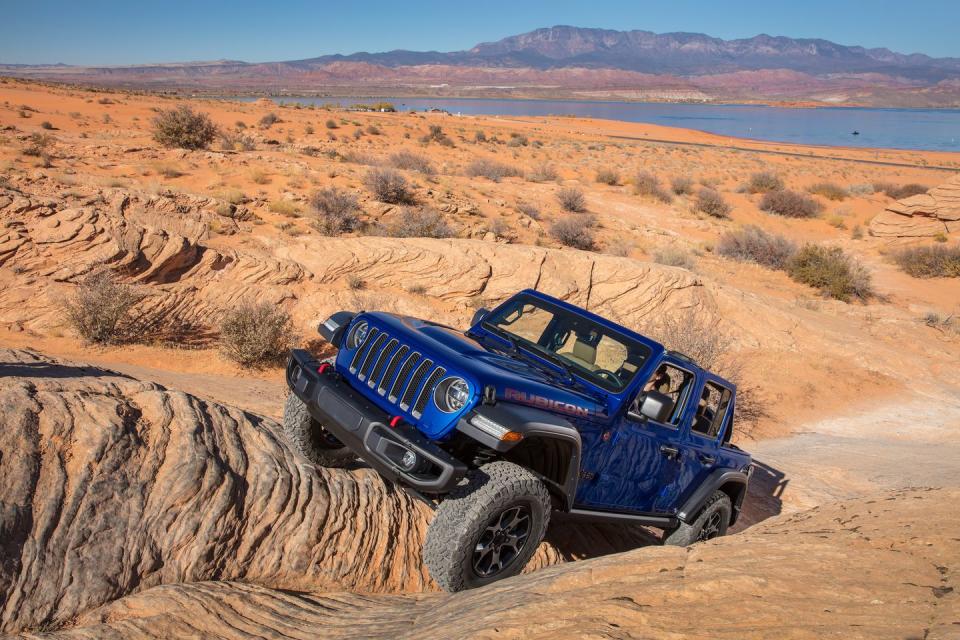We Test the 2020 Jeep Wrangler EcoDiesel

The Jeep Wrangler is a lot like a Subway franchise. It's a common sight at strip malls, regular malls, and gas stations. It comes in long and short sizes. And it offers a number of toppings, both soft and hard. With its various powertrains, door types, and streetable and/or off-road pretentions, the Wrangler has a combo for nearly any buyer. And now Jeep is introducing yet another flavor: the 2020 Jeep Wrangler EcoDiesel, which borrows its turbo-diesel from the 2020 Ram 1500. And with it comes a promise of improved fuel economy. All the taste. Fewer calories.
Wranglers have always paired well with the low-end grunt of a diesel engine. In the 1960s, the CJ-5 offered a four-cylinder diesel with 62 horsepower and 143 lb-ft of torque. For 2020, Jeep has bolted in a third-generation turbocharged 3.0-liter diesel V-6 made by VM Motori. It's mechanically the same as the Ram's engine, though the alternator and injection pump have been relocated to maintain the Wrangler's 30 inches of water-fording ability. Its 260 horsepower and 442 lb-ft of very lovely torque are the special sauce.

As the engine whirs to life, there's no mistaking that you bought the diesel. Jeep made an effort to quiet the pitter-patter of the powertrain, adding sound-deadening material to the engine-bay side of the firewall as well as foam to the back of the infotainment screen. But Jeeps are noisy creatures even without a diesel engine. After all, the doors and roof are removable. So, we largely enjoyed the clatter and thrum. The diesel is an expensive fixin'; we want to hear what we paid for. Would you spend thousands on a Hellcat engine and not listen to it? No. No, you would not.
Around town, the Ecodiesel supports big-rig fantasies. There's no manual gearbox, but there's a certain amount of joy that comes from locking the ZF-sourced eight-speed automatic into a high gear and standing on the accelerator. As the turbo spools up, its whistle drowns out the clatter as the intake gets stuffed with 18.7 pounds of boost. Peak torque arrives at 1400 rpm and stays flat all the way to 2800. Get out of it and the blow-off valve lets loose with a characteristic whoosh.

At the track, this 4863-pound Wrangler Unlimited Sahara recorded an impressive 6.7-second dash to 60 mph. The quarter-mile happens in 15.2 seconds, with the Jeep crossing the line at 89 mph. While it isn't the quickest Wrangler we've run through the numbers, the difference is so negligible that it will go unnoticed. Plus, the diesel's off-the-line acceleration never fails to result in a grin.
On the road, the Wrangler drives very much like an off-roader; two live axles and the quickest recirculating-ball-steering gear available in a Wrangler (at 14.3:1) isn't a recipe for apex hunting. On the skidpad, there's a meager 0.64 g of grip. To compensate for this ute's additional 394 pounds over a similarly equipped V-6 model, Jeep increased the front and rear spring rates by 10 percent and added diesel-specific dampers, making the ride noticeably firmer. The huskier Wrangler also needed 198 feet to stop from 70 mph. That's 22 more than the gasser Sahara V-6.

In the dirt, the diesel-powered Rubicon model earns its stripes. We ventured to Utah's spectacular Sand Hollow State Park so we could experience what Wranglers do best: Jeep things. With the Rubicon-specific front anti-roll bar disconnected and the front and rear electronic differentials locked, it climbed sandstone walls. The diesel shrugs off the weight of the truck, needing barely any accelerator input. Jeep's most serious Wrangler used up every one of its 10.8 inches of ground clearance, its skid plates dragging across the rock like fingernails on a chalkboard.
In deep sand, the Rubicon's off-road tires toss up earth as the engine churns away at full tilt. Sport and Sahara models are equipped with an open front differential and a limited-slip rear unit. Depending on the trim level, two transfer cases are offered: Sport and Sahara models are equipped with a 2.72:1 low-range ratio while the Rubicon is fitted with a 4.00:1. Unlike gasoline-powered Wranglers, a full-time all-wheel-drive transfer case isn't offered on the diesel.

Aft of the rear axle is a diesel-specific skid plate that protects the 5.1-gallon tank for diesel exhaust fluid. The reservoir does not have any negative impact on the Wrangler's departure angle and, by Jeep's claim, should need to be refilled only every 10,000 miles under normal operation. However, after drinking 2.5 gallons of tailpipe-cleansing juice with 1700 miles on the odometer, we're skeptical of this claim.
The diesel is more than just a power story. This powertrain is also about efficiency. Though EPA figures are not available at this time, we recorded a commendable 25 mpg during our 700-mile drive from Utah to Southern California.

The power efficiency comes with a hefty price, though. The engine alone is a $4000 option and requires a mandatory $2000 upgrade for the eight-speed automatic. At launch, the engine will be available only in four-door Unlimited models. Our well-equipped Sahara stickered at an eye-watering $57,940, and fully kitted Rubicons can climb into the mid-$60s. For bargain shoppers, the diesel can be had on the value menu for under $40,000 in the Wrangler Sport. We see this as the sweet spot in the range, as the savings can be spent on a lift kit, LED lights, and overlanding items. We'll have to wait a year for the diesel to appear in the Gladiator pickup, but it's presence in the Wrangler is the sandwich of the day.
You Might Also Like

